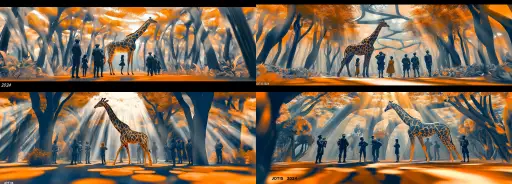Explore the Best AI Image Gallery

AI: The New Creative Collaborator
The world of graphic design is undergoing a dramatic transformation, fueled by the rapid advancements in artificial intelligence (AI). AI algorithms are now capable of generating stunning visuals, automating tedious tasks, and even offering creative suggestions that can push the boundaries of traditional design. This new wave of technology is not about replacing human designers but rather empowering them with powerful tools to enhance their creativity and efficiency.
Potential Uses of AI in Graphic Design
- Logo Design: AI-powered platforms can generate a variety of logo concepts based on user input, such as company name, industry, and desired style. This allows designers to quickly explore numerous options and refine their choices.
- Image Generation: AI algorithms can create original images from text descriptions (text-to-image generation), opening up exciting possibilities for concept art, illustrations, and marketing materials.
- Typography and Font Design: AI can analyze existing fonts and generate new variations, helping designers create unique and innovative typographic solutions.
- Website and UI/UX Design: AI can assist in designing website layouts, user interfaces, and interactive elements, streamlining the design process and ensuring a user-friendly experience.
- Marketing Materials: AI can generate graphics for social media posts, email campaigns, and other marketing collateral, saving designers time and resources.
Ethical Considerations of AI in Design
While the potential benefits of AI in graphic design are immense, its crucial to address the ethical considerations surrounding its use:
- Copyright and Ownership: Questions arise regarding the ownership of AI-generated content. Who holds the copyright – the user who provides the input or the AI developer?
- Bias and Representation: AI algorithms are trained on vast datasets, which can potentially contain biases that reflect societal stereotypes. Its important to ensure that AI-generated designs are inclusive and representative of diverse communities.
- Job Displacement: There are concerns that AI could automate certain design tasks, leading to job losses in the creative industry. However, its more likely that AI will shift the nature of design work, requiring designers to develop new skills and collaborate with AI tools.
- Transparency and Explainability: The decision-making processes of some AI algorithms can be complex and opaque. Its important to strive for transparency in how AI is used in design to build trust and accountability.
Future Trends in AI and Graphic Design
The future of AI in graphic design holds immense promise:
- More Personalized Designs: AI will enable the creation of highly personalized designs tailored to individual users preferences and needs.
- Real-Time Design Collaboration: AI-powered tools will facilitate seamless collaboration between designers, clients, and stakeholders in real time.
- Integration with Other Technologies: AI will be increasingly integrated with other technologies such as virtual reality (VR), augmented reality (AR), and the metaverse, opening up new frontiers for creative expression.
- Ethical AI Development: The design community will continue to prioritize the development and deployment of ethical AI tools that promote fairness, inclusivity, and transparency.
The integration of AI into graphic design is transforming the industry, offering both exciting opportunities and challenges. By embracing this technology responsibly and ethically, designers can unlock new creative possibilities and shape the future of visual communication.




](https://images.ai-img.art/thumbnails/150/c2c9c48b38fae37f0a457b80b084ed01ba803810fc8f488c8f610c03abc74049.webp)






](https://images.ai-img.art/thumbnails/150/008b5d5d49667cc2e93a5f8a8adfaa545963da99c39ff0901f5296294636400d.webp)














](https://images.ai-img.art/thumbnails/150/f9584153b4cddd8c9fab611dc10247549b275c59bc173251e37d0935874f9deb.webp)





](https://images.ai-img.art/thumbnails/150/bddf3ae4a232290858389b933c866ad3be429ef2e25c23a9f4d7713ed6e44d0b.webp)






](https://images.ai-img.art/thumbnails/150/4289d1230b86a96c4d556636c3167bed0ef38f850826549517e4e45db4d87bf7.webp)
](https://images.ai-img.art/thumbnails/150/f67d9af3398150f2ab1bcf250717fea134275e2ca896252b54a4d9bb3719f9ac.webp)
